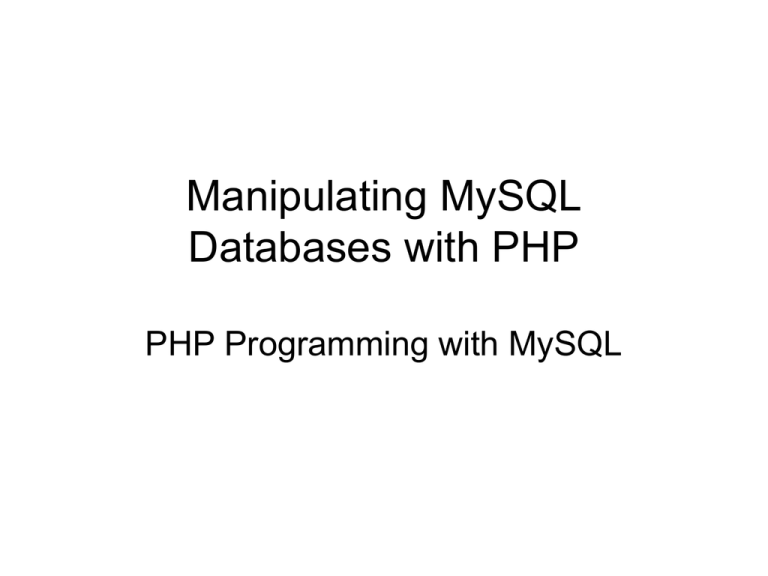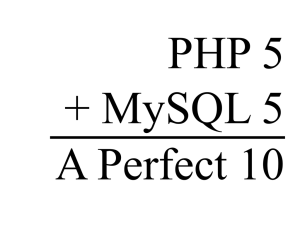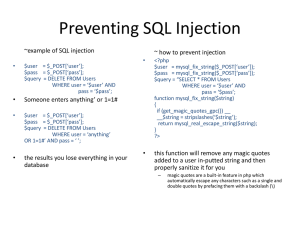php-mysqli
advertisement

Manipulating MySQL
Databases with PHP
PHP Programming with MySQL
Objectives
In this lesson, you will:
• Connect to MySQL from PHP
• Work with MySQL databases using PHP
• Create, modify, and delete MySQL tables with
PHP
• Use PHP to manipulate MySQL records
• Use PHP to retrieve database records
2
Connecting to MySQL with PHP
• PHP has the ability to access and manipulate any
database that is ODBC compliant
• PHP includes functionality that allows you to work
directly with different types of databases, without going
through ODBC
3
Determining which MySQL
Package to Use
• The mysqli (MySQL Improved) package became
available with PHP 5 and is designed to work with
MySQL version 4.1.3 and later
• Earlier versions must use the mysql package
• The mysqli package is the object-oriented equivalent of
the mysql package but can also be used procedurally
• Mysqli package has improved speed, security and
compatibility with libraries.
4
Opening and Closing a MySQL
Connection
• Open a connection to a MySQL database server with
the mysqli_connect() function
• The mysqli_connect() function returns a positive
integer if it connects to the database
successfully or FALSE if it does not
• Assign the return value from the mysqli_connect()
function to a variable that you can use to access
the database in your script
5
Opening and Closing a MySQL
Connection (continued)
• The syntax for the mysqli_connect()
function is:
$connection = mysqli_connect("host" [,
"user", "password"[,”database”]]);
• The host argument specifies the host name
where your MySQL database server is installed
• The user and password arguments specify a MySQL
account name and password
• You can optionally select the database when
connecting.
6
Opening and Closing a MySQL
Connection (continued)
• The database connection is assigned to the
$DBConnect variable
$DBConnect = mysqli_connect("localhost",
"billyeakus ", "hotdog");
•
Close a database connection using the mysql_close()
function
mysqli_close($DBConnect);
7
Opening and Closing a MySQL
Connection (continued)
mysqli_get_client_info()
mysqli_get_client_stats()
mysqli_get_client_version()
mysqli_get_connection_stats()
mysqli_get_host_info()
mysqli_get_proto_info()
mysqli_get_server_info()
mysqli_get_server_version()
Returns the MySQL client library version
Returns statistics about client per-process
Returns the MySQL client library version as an integer
Returns statistics about the client connection
Returns the MySQL server hostname and the
connection type
Returns the MySQL protocol version
Returns the MySQL server version
Returns the MySQL server version as an integer
8
Opening and Closing a MySQL
Connection (continued)
version.php in a Web browser
9
Reporting MySQL Errors
• Reasons for not connecting to a database
server include:
– The database server is not running
– Insufficient privileges to access the data source
– Invalid username and/or password
10
Reporting MySQL Errors
(continued)
• The mysqli_errno() function returns the error code from
the last attempted MySQL function call or 0 if no error
occurred
• The mysqli_error() — Returns the text of the error
message from previous MySQL operation
• The mysqli_errno() and mysqli_error() functions return
the results of the previous mysqli*() function
11
Selecting a Database
• The syntax for the mysqli_select_db() function
is:
mysqli_select_db(connection, database);
• The function returns a value of TRUE if it
successfully selects a database or FALSE if it
does not
• For security purposes, you may choose to use
an include file to connect to the MySQL server
and select a database
12
Sample Code
good
$link = mysqli_connect("cs.mvnu.edu",
“demo", “demo");
bad
good
bad
mysqli_select_db($link, "nonexistentdb",
echo mysql_errno($link) . ": " .
mysql_error($link). "<br>";
mysqli_select_db( $link, “demo");
mysqli_query($link,
"SELECT * FROM nonexistenttable");
echo mysqli_errno($link) . ": " .
mysqli_error($link) . "<br>";
13
Sample Code
$host='localhost';
$userName = 'demo';
$password = 'demo';
$database ='demo';
$link = mysqli_connect ($host, $userName,
$password) ;
if (!$link) {
die('Could not connect: ' . mysqli_error($link
));
}
echo 'Connected successfully';
mysqli_close($link);
14
Sample Code
<?php
$link = mysqli_connect('localhost', 'mysql_us
er', 'mysql_password');
if (!$link) {
die('Not connected : ' . mysqli_error($li
nk));
}
// make foo the current db
$db_selected = mysqli_select_db($link,'foo');
if (!$db_selected) {
die ('Can\'t use foo : ' . mysqli_error($
link));
}
?>
15
Suppressing Errors with the Error
Control Operator
• By default, functions in the mysql package
display errors and warnings as they occur
• Use the error control operator (@) to suppress
error messages
• The error control operator can be prepended to
any expression although it is commonly used
with expressions
16
Executing SQL Statements
• Use the mysqli_query() function to send SQL
statements to MySQL
• The syntax for the mysqli_query() function is:
mysqli_query(connection, query);
• The mysqli_query() function returns one of three
values:
– For SQL statements that do not return results
(CREATE DATABASE and CREATE TABLE
statements) it returns a value of TRUE if the
statement executes successfully
17
Executing SQL Statements
(continued)
– For SQL statements that return results (SELECT
and SHOW statements) the mysqli_query()
function returns a result pointer that represents
the query results
• A result pointer is a special type of variable that
refers to the currently selected row in a resultset
– The mysqli_query() function returns a value
of FALSE for any SQL statements that fail,
regardless of whether they return results
18
Sample Code
•
<?php
// This could be supplied by a user, for example
$firstname = 'fred';
$lastname = 'fox';
•
•
//never trust user data
$firstname= mysql_real_escape_string($firstname);
$lastname= mysql_real_escape_string($lastname);
// Formulate Query
// For more examples, see mysql_real_escape_string()
$query = "SELECT firstname, lastname, address, age FROM friends WHERE firstname=‘$firstname ‘
AND lastname= ‘$lastname’”;
// Perform Query
$result = mysql_query($query);
// Check result
// This shows the actual query sent to MySQL, and the error. Useful for debugging.
if (!$result) {
$message = 'Invalid query: ' . mysql_error() . "<br>";
$message .= 'Whole query: ' . $query;
die($message);
}
// Use result
// Attempting to print $result won't allow access to information in the resource
// One of the mysql result functions must be used
// See also mysql_fetch_array(), mysql_fetch_row(), etc.
while ($row = mysql_fetch_assoc($result)) {
echo $row['firstname'];
echo $row['lastname'];
echo $row['address'];
echo $row['age'];
}
// Free the resources associated with the result set
// This is done automatically at the end of the script
mysql_free_result($result);
?>
19
Adding, Deleting, and Updating
Records
• To add records to a table, use the INSERT and
VALUES keywords with the mysqli_query()
function
• To add multiple records to a database, use the
LOAD DATA statement with the name of the
local text file containing the records you want to
add
• To update records in a table, use the UPDATE
statement
20
Adding, Deleting, and Updating
Records
<?php
$con = mysqli_connect("localhost","demo","demo");
if (!$con)
{
die('Could not connect: ' . mysqli_error($con));
}
mysqli_select_db($con, "demo");
mysqli_query($con, "INSERT INTO friends (FirstName,
LastName, Age) VALUES ('Les\
ter', 'Longbottom', '35')");
mysqli_query($con,"INSERT INTO friends (FirstName,
LastName, Age) VALUES ('Carl\
y', 'Sampson', '33')");
mysqli_close($con);
?>
Adding, Deleting, and Updating
Records (continued)
• The UPDATE keyword specifies the name of the
table to update
• The SET keyword specifies the value to assign to
the fields in the records that match the condition in
the WHERE clause
• To delete records in a table, use the DELETE
statement with the mysqli_query() function
• Omit the WHERE clause to delete all records in a
table
22
Adding, Deleting, and Updating
Records
From W3c
?php
$con =
mysqli_connect("localhost","demo","demo");
if (!$con)
{
die('Could not connect: ' .
mysqli_error($con));
}
mysqli_select_db($con,"demo");
mysqli_query($con,"UPDATE friends SET Age =
'61'
WHERE FirstName = 'Bill' AND LastName =
'Yeakus'");
mysqli_close($con);
?>
Retrieving Records into an
Indexed Array
The mysql_fetch_row() function returns the fields
in the current row of a resultset into an indexed
array and moves the result pointer to the next
row
echo "<table border=1>";
echo "<tr><th>First</th><th>Last</th>
<th>Address</th><th>age</th></tr>";
$Row = mysqli_fetch_row($result);
do {
echo "<tr><td>{$Row[0]}</td>";
echo "<td>{$Row[1]}</td>";
echo "<td>{$Row[2]}</td>";
echo "<td>{$Row[3]}</td></tr>";
$Row = mysqli_fetch_row($result);
} while ($Row);
echo "</table>";
mysqli_close($con);
?>
24
Sample Code
<?php
$con = mysqli_connect("localhost","demo","demo","demo");
if (!$con)
{
die('Could not connect: ' . mysqli_error($con));
}
$q = "SELECT * FROM friends";
$result = mysqli_query($con,$q);
echo "<table border=1>";
echo "<tr><th>First</th><th>Last</th>
<th>Address</th><th>age</th></tr>";
while ($Row=mysqli_fetch_assoc($result)) {
echo "<tr><td>{$Row['firstname']}</td>";
echo "<td>{$Row['lastname']}</td>";
echo "<td>{$Row['address']}</td>";
echo "<td>{$Row['age']}</td></tr>";
}
echo "</table>";
mysqli_close($con);
?>
25
Using the mysqli_affected_rows()
Function
• With queries that return results (SELECT queries), use
the mysqli_num_rows() function to find the number of
records returned from the query
• With queries that modify tables but do not return results
(INSERT, UPDATE, and DELETE queries), use the
mysqli_affected_rows() function to determine the number
of affected rows
26
Using the mysql_affected_rows()
Function (continued)
$QueryResult = mysqli_query($con,"UPDATE friends SET
Age = '67'
WHERE FirstName = 'Bill' AND LastName = 'Yeakus'");
if ($QueryResult === FALSE)
echo "<p>Unable to execute the query.</p>"
. "<p>Error code " . mysqli_errno($con)
. ": " . mysqli_error($con) . "</p>";
else
echo "<p>Successfully updated "
. mysqli_affected_rows($con) . "
record(s).</p>";
mysql_close($con);
?>
27
Using the mysql_affected_rows()
Function (continued)
Output of mysql_affected_rows() function
for an UPDATE query
28
Using the mysql_info() Function
• For queries that add or update records, or alter
a table’s structure, use the mysqli_info() function to
return information about the query
• The mysqli_info() function returns the number of
operations for various types of actions, depending on the
type of query
• The mysqli_info() function returns information about the
last query that was executed on the database connection
29
Using the mysqli_info()
Function (continued)
• The mysqli_info() function returns information
about queries that match one of the following
formats:
–
–
–
–
–
INSERT INTO...SELECT...
INSERT INTO...VALUES (...),(...),(...)
LOAD DATA INFILE ...
ALTER TABLE ...
UPDATE
• For any queries that do not match one of these
formats, the mysql_info() function returns an
empty string
30
Using the mysql_info() Function
(continued)
$SQLstring = "INSERT INTO company_cars " .
" (license, model_year, make, model, mileage) " .
" VALUES " .
" ('CPQ-894', 2011, 'Honda', 'Insight', 49.2), " .
" ('CPQ-895', 2011, 'Honda', 'Insight', 17.9), " .
" ('CPQ-896', 2011, 'Honda', 'Insight', 22.6)";
$QueryResult = @mysqli_query($DBConnect,$SQLstring);
if ($QueryResult === FALSE)
echo "<p>Unable to execute the query.</p>"
. "<p>Error code " . mysql_errno($DBConnect)
. ": " . mysqli_error($DBConnect) . "</p>";
else {
echo "<p>Successfully added the record.</p>";
echo "<p>" . mysqli_info($DBConnect) . "</p>";
}
31
Using the mysql_info() Function
(continued)
Output of mysqli_info() function for an
INSERT query that adds multiple records
32
Using the mysqli_info()
Function (continued)
• The mysqli_info() function also returns information
for LOAD DATA queries
$SQLstring = "LOAD DATA INFILE 'company_cars.txt'
INTO TABLE company_cars;";
$QueryResult = @mysqli_query($SQLstring, $DBConnect);
if ($QueryResult === FALSE)
echo "<p>Unable to execute the query.</p>"
. "<p>Error code " . mysqli_errno($DBConnect)
. ": " . mysqli_error($DBConnect) . "</p>";
else {
echo "<p>Successfully added the record.</p>";
echo "<p>" . mysqli_info($DBConnect) . "</p>";
}
33
Using the mysql_info() Function
(continued)
Output of mysqli_info() function for a
LOAD DATA query
34
Working with Query Results
35
Retrieving Records into an Indexed
Array
• The mysqli_fetch_row() function returns
the fields in the current row of a result set
into an indexed array and moves the result
pointer to the next row
36
Retrieving Records into an Indexed
Array
$q = "SELECT * FROM friends";
$result = mysqli_query($con,$q);
echo "<table border=1>";
echo "<tr><th>First</th><th>Last</th>
<th>Address</th><th>age</th></tr>";
$Row = mysqli_fetch_row($result);
do {
echo "<tr><td>{$Row[0]}</td>";
echo "<td>{$Row[1]}</td>";
echo "<td>{$Row[2]}</td>";
echo "<td>{$Row[3]}</td></tr>";
$Row = mysql_fetch_row($result);
} while ($Row);
echo "</table>";
mysqli_close($con);
37
Retrieving Records into an Indexed
Array
38
Retrieving Records into an
Associative Array
• The mysqli_fetch_assoc() function returns the
fields in the current row of a resultset into an
associative array and moves the result pointer to
the next row
• The difference between mysqli_fetch_assoc() and
mysqli_fetch_row() is that instead of returning the
fields into an indexed array, the
mysqli_fetch_assoc() function returns the fields
into an associate array and uses each field name as
the array key
39
Closing Query Results
• When you are finished working with query results
retrieved with the mysqli_query() function, use
the mysqli_free_result() function to close the
resultset
• To close the resultset, pass to the
mysqli_free_result() function the
variable containing the result pointer from the
mysqli_query() function
40
Accessing Query Result
Information
• The mysqli_num_rows() function returns the number
of rows in a query result
• The mysqli_num_fields() function returns the
number of fields in a query result
• Both functions accept a database connection
variable as an argument
41
Accessing Query Result
Information (continued)
$SQLstring = "SELECT * FROM company_cars";
$QueryResult = @mysqli_query($DBConnect$, SQLstring);
if ($QueryResult === FALSE)
echo "<p>Unable to execute the query.</p>"
. "<p>Error code " . mysqli_errno($DBConnect)
. ": " . mysqli_error($DBConnect) . "</p>";
else
echo "<p>Successfully executed the query.</p>";
$NumRows = mysqli_num_rows($QueryResult);
$NumFields = mysqli_num_fields($QueryResult);
if ($NumRows != 0 && $NumFields != 0)
echo "<p>Your query returned " .
mysqli_num_rows($QueryResult) . " rows and "
. mysqli_num_fields($QueryResult) . " fields.</p>";
else
echo "<p>Your query returned no results.</p>";
mysqli_close($DBConnect);
42
Accessing Query Result
Information (continued)
Output of the number of rows and fields
returned from a query
43
Summary
• The mysqli_connect() function opens a connection
to a MySQL database server
• The mysqli_close() function closes a database
connection
• The mysqli_errno() function returns the error code
from the last attempted MySQL function call or
zero if no error occurred
44
Summary (continued)
• The mysqli_error() function returns the error
message from the last attempted MySQL function
call or an empty string if no error occurred
• The error control operator (@) suppresses error
messages
• You use the mysqli_create_db() function to create
a new database
• The mysqli_select_db() function selects a database
45
Summary (continued)
• You use the mysqli_drop_db() function to delete a
database
• The mysqli_query() function sends SQL statements
to MySQL
• A result pointer is a special type of variable
that refers to the currently selected row in a
resultset
• You use the CREATE TABLE statement with the
mysqli_query() function to create a table
46
Summary (continued)
• The PRIMARY KEY clause indicates a field or fields
that will be used as a referential index for the
table
• The AUTO_INCREMENT clause creates a field that is
automatically updated with the next sequential
value for that column
• The NOT NULL clause creates a field that must
contain data
• You use the DROP TABLE statement with the
mysqli_query() function to delete a table
47
Summary (continued)
• You use the LOAD DATA statement and the
mysqli_query() function with a local text file to
add multiple records to a database – MAY NOT WORK
ON PARADOX
• You use the UPDATE statement with the
mysqli_query() function to update records in a
table
• You use the DELETE statement with the
mysqli_query() function to delete records from a
table
48
Summary (continued)
• The mysqli_info() function returns the number of
operations for various types of actions, depending
on the type of query.
• The mysqli_fetch_row() function returns the fields
in the current row of a resultset into an indexed
array and moves the result pointer to the next
row.
49
Summary (continued)
• The mysqli_fetch_assoc() function returns the
fields in the current row of a resultset into an
associative array and moves the result pointer to
the next row
• The mysqli_free_result() function closes a
resultset
50
Summary (continued)
• The mysqli_num_rows() function returns the number
of rows in a query result, and the
mysqli_num_fields() function returns the number of
fields in a query result
• With queries that return results, such as SELECT
queries, you can use the mysqli_num_rows()
function to find the number of records returned
from the query
51
Creating and Deleting Tables
• Use the CREATE TABLE statement with the
mysqli_query() function to create a new table
• Use the mysqli_select_db() function before
executing the CREATE TABLE statement to verify
that you are in the right database
52
Creating and Deleting Tables
(continued)
53
Creating and Deleting Tables
(continued)
Error code and message that displays when you
attempt to create a table that already exists
54
Creating and Deleting Tables
(continued)
• Use the SHOW TABLES LIKE command to prevent code
from trying to create a table that already exists.
• If the table does not exist, the
mysqli_num_rows()function will return a value of 0
rows
$TableName = "subscribers";
$SQLstring = "SHOW TABLES LIKE '$TableName'";
$QueryResult = @mysqli_query($DBConnect,
$SQLstring);
55
Creating and Deleting Tables
(continued)
• To identify a field as a primary key in MySQL,
include the PRIMARY KEY keywords when you define a
field with the CREATE TABLE statement
• The AUTO_INCREMENT keyword is often used with a
primary key to generate a unique ID for each new
row in a table
• The NOT NULL keywords are often used with primary
keys to require that a field include a value
56
Creating and Deleting Tables
(continued)
• To delete a table, use the DROP TABLE statement
with the mysqli_query() function
57
Creating a Database
• Use the mysqli_create_db() function to
create a new database
• The basic syntax for the
mysqli_create_db() is:
$result = mysqli_create_db(connection, "dbname" );
• The mysqli_create_db() returns a
Boolean TRUE if successful or FALSE if
there was an error
• In most cases we will use mysql
monitor, PhpMyAdmin or Workbench to
create databases.
58
Creating a Database (continued)
Error message when the mysqli_create_db() function
is unavailable because of insufficient privileges
59
Deleting a Database
• To delete a database, use the mysqli_drop_db()
function.
• The format for the mysql_drop_db() function is:
$Result = mysqli_drop_db($connection,
"dbname");
• The function returns a value of TRUE if it
successfully drops a database or FALSE if it
does not
60






